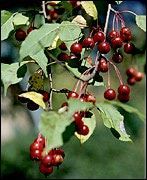One of the longest nerves in the body is known as the vagus nerve (VN). The VN is the 10th pair of cranial nerves that originates at the brain stem in the medulla oblongata. This nerve is part of the parasympathetic nervous system, which is a part of the ANS. Research suggests ear acupuncture can activate the VN.
Herbs & Botanicals
Cranberry (vaccinium macrocarpon)
What is cranberry? What is it used for?
Native to North America, the cranberry is a small, red berry that belongs to the same family as blueberries and bilberries. Cranberry bushes usually grow in bogs and swampy regions, and are small, red, and rather tart. They are often used in cooking, and are a traditional dish at many holiday dinners. In addition to its culinary uses, cranberry has been prized for its healing properties as well.
Traditionally, cranberry has been used by herbalists to remove toxins from the blood and reduce the formation of kidney stones. One of the most popular uses for cranberries today is to help prevent urinary tract infections. Substances in cranberry juice called proanthocyanidins exihibit anti-adherence properties, which prevent the E. coli bacteria that cause most urinary tract infections from adhering to the wall of the bladder. There is also evidence that cranberry juice can help prevent plaque-forming bacteria from binding to the surface of one's teeth, reducing the incidence of cavities, gingivitis and gum disease.
How much cranberry should I take?
 To prevent urinary tract infections, many practitioners recommend drinking three or more ounces of cranberry juice cocktail (containing at least 30 percent cranberry juice) daily. As an alternative, patients may take between four and six 500-milligram capsules of dried cranberry powder. To treat an existing urinary tract infection, many practitioners recommend between 6,000 and 8,000 milligrams of a standardized cranberry extract, divided into three or four doses, or between 12 and 32 ounces of cranberry juice cocktail per day. Taking vitamin C is believed to improve cranberry's healing effects, along with drinking generous amounts of water.
To prevent urinary tract infections, many practitioners recommend drinking three or more ounces of cranberry juice cocktail (containing at least 30 percent cranberry juice) daily. As an alternative, patients may take between four and six 500-milligram capsules of dried cranberry powder. To treat an existing urinary tract infection, many practitioners recommend between 6,000 and 8,000 milligrams of a standardized cranberry extract, divided into three or four doses, or between 12 and 32 ounces of cranberry juice cocktail per day. Taking vitamin C is believed to improve cranberry's healing effects, along with drinking generous amounts of water.
What forms of cranberry are available?
Cranberry is available in a variety of forms, ranging from fresh berries to teas, powders, tinctures, tablets, extracts and capsules. Many of these can be purchased at health food stores or supermarkets. However, most cranberry juice cocktails contain only 30 percent cranberry juice. High-quality, full-strength cranberry juice can be found at some health food stores.
What can happen if I take too much cranberry? Are there any interactions I should be aware of? What precautions should I take?
Drinking large amounts of cranberry juice may cause diarrhea or upset stomach. However, no serious side-effects have been noted when cranberry is taken in supplement form. It is considered safe for use by women who are pregnant or breastfeeding.
Certain medications may interact with cranberry products. Patients taking medications to treat their kidneys or urinary tract should not take cranberry products without first consulting with a licensed health care provider. As always, make sure to consult with a licensed health care practitioner before taking cranberry or any other herbal remedy or dietary supplement.
References
- Avorn J, Monane M, Gurwitz JH, et al. Reduction of bacteriuria and pyruria after ingestion of cranberry juice. JAMA 1994;271:751-4.
- Leaver RB. Cranberry juice. Prof Nurse 1996;11:525-6.
- Lynch DM. Cranberry for prevention of urinary tract infections. Am Fam Physician Dec 1, 2004;70(11):2175-7.
- Weiss EI, Houri-Haddad Y, Greenbaum E, et al. Cranberry juice constituents affect influenza virus adhesion and infectivity. Antiviral Res Apr 2005;66(1):9-12.
- Zafriri D, Ofek I, Adar R, et al. Inhibitory activity of cranberry juice on adherence of type 1 and type P fimbriated wscherichia coli to eucaryotic cells. Antimicrob Agents Chemother 1989;33:92-8.


